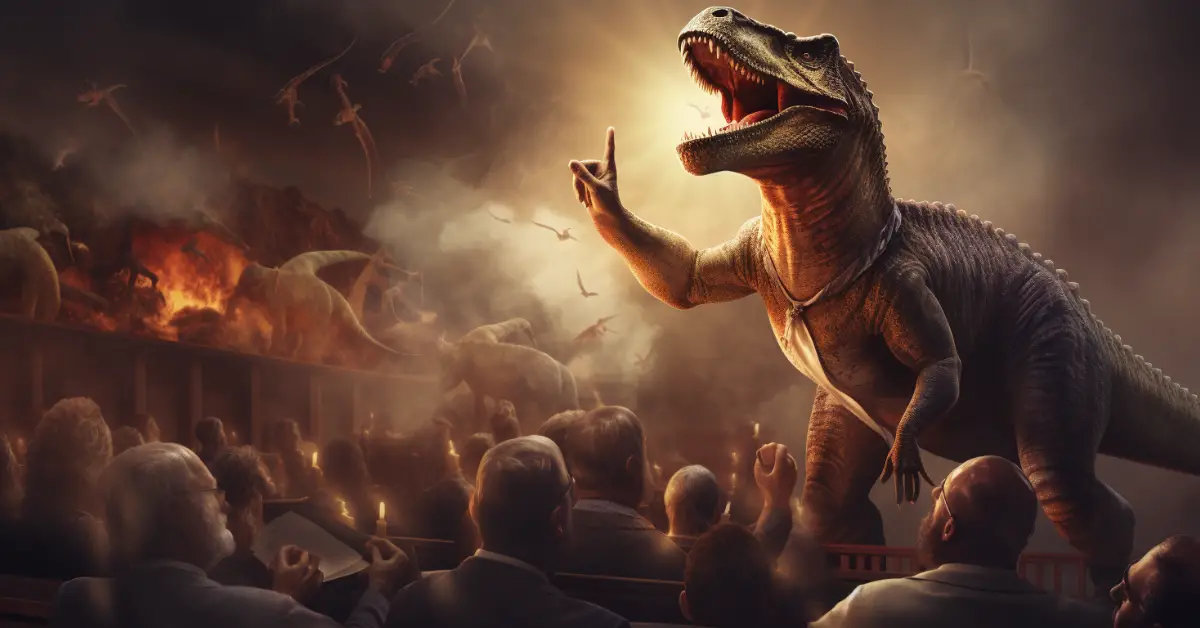Some people wonder if the Bible, a collection of texts spanning thousands of years, has anything to say about dinosaurs. The truth is, the word “dinosaur” never directly appears in the Bible, since it was coined long after the Bible was written. However, there are several references in the Old Testament, particularly in Job and Psalms, that describe creatures resembling dinosaurs, like “behemoth” and “leviathan.” While these descriptions are open to interpretation, they provide a hint that people of ancient times might have been aware of dinosaur-like creatures. The Bible’s primary focus is on human’s relationship with God and the path to salvation through Jesus, so it doesn’t delve into scientific details about the Earth’s history or its prehistoric inhabitants. Nonetheless, the indirect references ignite curiosity and discussions around the coexistence of humans and dinosaurs.
If you’ve ever wondered about the relationship between dinosaurs and biblical teachings, keep reading. There’s more to explore, and the connections might surprise you!
What Does the Bible Say About Dinosaurs?
The Bible isn’t a science book, yet it offers glimpses into the past that seem to intersect with scientific discoveries about dinosaurs. It refers to creatures like “behemoth,” found in Job 40:15-24, described as an immense animal with a tail like a cedar tree, seemingly resembling a sauropod. Another creature, “leviathan,” is described in Job 41 and Psalms 104:26 as a fire-breathing sea creature, which stirs imagination and discussions about what this creature might have been.
These references to behemoth and leviathan have been the center of many debates. Some people interpret them literally, thinking they could be descriptions of dinosaurs or other prehistoric creatures, while others believe they are metaphorical or symbolic, representing chaos and evil. It’s also argued that these could be descriptions of animals that were known at the time, like hippos or crocodiles, depicted in a mythical and exaggerated manner.
When discussing the Bible and dinosaurs, it’s essential to consider the perspective of ancient people and the context in which they wrote. The Bible was written in a pre-scientific era, and its authors used the language and concepts available to them to convey spiritual truths, moral principles, and God’s view on life and existence. Therefore, the depiction of these creatures in the Old Testament might not aim to provide accurate zoological information but rather to communicate spiritual lessons.
Jesus, central to the New Testament, focused his teachings on love, faith, sin, and redemption, and did not address the existence of dinosaurs. The New Testament authors, guided by the Holy Spirit, also concentrated on themes more central to human salvation and morality and did not delve into discussions about prehistoric creatures.
So, while the Bible does not provide clear, direct information about dinosaurs, the intriguing references to colossal creatures allow room for speculation and reflection on whether the people of biblical times had knowledge or awareness of dinosaurs. The coexistence of humans and dinosaurs isn’t directly addressed, and discussions around this topic usually involve considerations of the age of the Earth and the interpretation of the creation days in Genesis.
Bible Verses About Dinosaurs
One key passage where a potential dinosaur-like creature is mentioned is Job 40:15-24, describing the behemoth. This creature is portrayed as having strength in its loins and power in the muscles of its belly; its tail sways like a cedar. The description could align with a sauropod dinosaur, which is known for its long neck and tail.
Another intriguing passage is Job 41, which portrays leviathan, a creature so formidable that only God can approach it. It’s described as having fearsome teeth and scales that are impervious to sword and spear. This creature is also mentioned in Psalms 104:26 as a sea creature created by God, again highlighting the divine creation of all creatures, regardless of their nature or time of existence.
Isaiah 27:1, which mentions the leviathan again, describing it as a “gliding serpent” that God will punish. The metaphorical or literal interpretation of the leviathan varies, but its recurrence suggests its significance in representing formidable, untamable aspects of creation.
The “behemoth” and “leviathan” are the most direct, potentially dinosaur-related references, but there are other verses that refer to “dragons,” such as Isaiah 30:6, where it describes a “fiery flying serpent.” This term stirs imagination, creating visions of dragon-like creatures that could resemble some forms of dinosaurs or pterosaurs, although many argue this is likely symbolic or exaggerated language used to convey a sense of danger and awe.
In Psalm 74:14, there is a reference to God crushing the heads of Leviathan. Here, many theologians propose that Leviathan is a symbol of chaos and evil, highlighting God’s triumph over such entities. The depiction of leviathan in various forms and contexts throughout the Bible exemplifies the multifaceted nature of biblical interpretation.
Nehemiah 2:13 references “the dragon well,” a term that evokes imagery of mysterious and fearsome creatures, though it doesn’t offer a detailed description of the “dragon.” It’s another instance where the language used is more to illustrate and emphasize than to provide specific zoological insights.
The book of Revelation, the last book of the New Testament, mentions “dragons” symbolically to depict evil forces opposing God. The use of “dragon” here is more aligned with representing spiritual entities rather than literal creatures, exemplifying the symbolic and metaphorical richness of biblical language.
While exploring these verses, it’s crucial to reflect on the nature of the Bible’s language, which is often poetic, symbolic, and illustrative, aimed at conveying spiritual truths rather than scientific facts. The representation of creatures like the leviathan and the behemoth, whether literal or metaphorical, accentuates the awe and wonder inherent in God’s creation and the omnipotence of God in creating and managing such powerful entities.
Whether these creatures mentioned were dinosaurs, other prehistoric animals, or symbols of chaos and divine power, their inclusion in the biblical narrative underscores the magnitude of God’s creation and His sovereign control over all elements of the universe. The discussions and reflections invoked by these verses encourage believers and seekers alike to explore the boundless depths of God’s wisdom and the endless wonders of His creation. The all-encompassing love of Jesus and the teachings of the New Testament guide believers in understanding their role in this magnificent creation, encouraging a life of love, humility, and reverence for all of God’s works.


